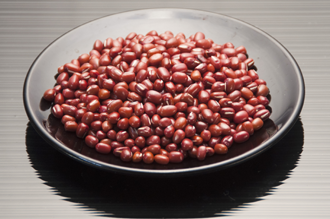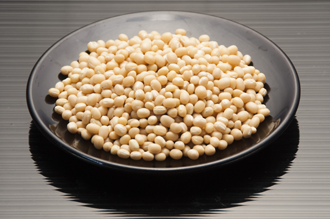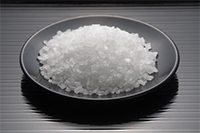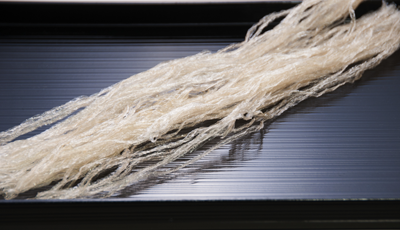Ingredients
生産者の皆さんの思いをお客様にお届けするのも当店の使命と考えております。
We believe that it is our duty to deliver eagerness and dedication of all the producers to our customers.
葛 – Kudzu 国産(奈良吉野)
|
 |
栄養分を多く含んだ冬眠中の根を採取し、
雑菌の繁殖が極端に少ない冬の吉野の清冽な寒水で
何度も何度も精製して白い葛粉が出来上がります。
当店では、奈良吉野の老舗店と、京都の老舗菓子店が提携して
厳選した「葛きり」に最も適した特注品を使用しております。
当店では厚く柔らかめにお作りしております。
短時間で食感が変化してしまいますが、
作りたての葛切りならではの繊細な喉ごしを大切にしております。
『森野葛本舗』公式サイトへ
|
|
Kudzu is harvested while its roots are dormant, because they contain rich nutrients at this time.
Kudzu is refined many times using the clean and cold waters of Yoshino in Nara Prefecture.
What we use is a specially ordered product exclusively chosen for Kudzukiri which has been hand-picked in collaboration with long-established stores in Yoshino, and in Kyoto.
The taste of freshly made Kudzukiri gets rather softened over time. Therefore some shops make it harder in advance.
A particular point of pride is the fine, jelly-like consistency of the freshly-made Kudzukiri.
『森野葛本舗』→Link
|
△ページの上に戻る
小豆 – Adzuki備中(岡山県笠岡)
|
|
丹波産と同等の備中(岡山県笠岡)産の小豆を使用しています。
当店が厳選しました大納言は、産地の地形から一日の寒暖の差が光合成を高め、また適度に湿潤な環境が整った肥沃な環境で栽培されたもので、
水分を多く含み、大粒で皮が柔らかく上品な風味が特長です。
Our hand-picked Dainagon adzuki beans which are produced in Bicchu (Kasaoka, Okayama Prefecture) are matched in quality only by the ones from Tanba,
the best brand in Japan.
The Dainagon beans were grown in fertile lands that have sufficient moistness as well as suitable changes in temperature between daytime and night-time.
The beans are large and moist with soft skins. You can savor their delicate flavor as well.
|
小豆
Adzuki

|
大納言
Dainagon

|
白小豆
Shiroadzuki

|
|
△ページの上に戻る
黒糖 – Kokutoh 国産(波照間)
|
 |
砂糖黍を搾り、煮詰め固めただけですので、
ミネラルが多く含まれ、長寿の秘訣と注目されております。
沖縄以南の島々でそれぞれの地勢に合った品種を栽培しています。
海風が運ぶ塩加減や適した品種などにより、
島ごとに個性がある風味、舌ざわりが生まれます。
当店では、その中から日本最南端の有人島である、
波照間島産の黒糖を使用しております。
『波照間精糖』公式サイトへ
|
|
When the producers make kokutoh, they simply boil down squeezed sugarcane until it gets hard.
This sugar contains lots of minerals, and is said to aid longevity.
Different varieties of kokutoh are produced on the islands located to the south of Okinawa,
and each has a different flavor and texture because of the salt carried on the island breeze, the form of each island, and the climate.
Among others, we use the most exclusive kokutoh made on the southernmost inhabited islet, Hateruma Island.
『波照間精糖』→Link
|
△ページの上に戻る
和三盆 – Wasanbon Sugar国産(四国阿波)
|
 |
徳島や香川の四国東部で伝統的に作られてきた砂糖の一種が和三盆です。
盆状の台の上で三度、手作業で研ぐ精製工程をくり返すことから、
和三盆と呼ばれています。
当店で使用している和三盆の原料は阿波徳島産の竹糖です。
栄養分がたっぷり含まれた竹糖の搾り汁を結晶化させて作ります。
砂糖の粒子を微細化する「研ぎ」の作業は熟練の伝統技法です。
『岡田製糖源』公式サイトへ
|
|
Wasanbon is a kind of sugar which has been traditionally produced in Tokushima and Kagawa prefectures in the east region of Shikoku.
The name ‘Wasanbon’ is originated from ‘togi’ or to knead sugar on a tray about three times.
Taketoh is a kind of sugarcane grown in Awa in the Shikoku region, and its extracted juice is full of nutrients.
The juice is crystallized, and this traditional technique of ‘togi’, in which grains of sugar are refined, requires skill. We use this Wasanbon in our shop.
『岡田製糖源』→Link
|
△ページの上に戻る
砂糖 – Sugar
|
|
砂糖黍や甜菜の搾り汁を精製して砂糖が作られます。
当店では、希少で一般には出回らない、白ザラよりもさらに精製度が高く甘さの切れが良い鬼ザラ、保湿性のよい上白糖、
さらには精製の工程で発生する焦げによる風味が増した三温糖などを使い分けております。
昔ながらの自然な甘味を追求し、漂白や加工、糖度を調整した砂糖などは一切使用しておりません。
Sugar is usually made by squeezing the juice of sugar canes or sugar beets and by refining them.
We use various kinds of sugar with traditional tastes depending on the products we make: a rare variety called Onizara that is more highly refined
and has a clearer sweetness than granulated white sugar, a moisture-rich superfine sugar,
known as Johakutoh and a soft brown sugar called Sanontoh which turns brown with a delicate flavor in the course of refining.
Whited, processed or artificially sweetened sugar is never used in our products.
|
鬼ザラ
Onizara

|
上白糖
Johakutoh

|
三温糖
Sanontoh

|
グラニュウ糖
granulated sugar

|
|
△ページの上に戻る
善哉 – Zenzai
|
 |
餅黍 – Mochikibi備中(岡山)産
五穀のひとつ、黍はイネ科の一年草です。粟と同様に「うるち種」と「もち種」があります。
当店では備中(岡山)産の餅黍を使用しています。
Mochikibi(millet rice cakes) is a kind of annual plant and belongs to five staple grains.
In Awa, it has two varieties, Uruchi and Mochi.
We use Mochikibi produced in Bicchu (Okayama Prefecture).
Although domestic products are hard to obtain,
we use Mochikibi from Nagasaki Prefecture.
|
 |
餅粟 – Mochiawa長崎産
餅粟は古くから栽培されてきた雑穀です。黍と同様に「うるち種」と「もち種」があります。
タンパク質や食物繊維、ミネラルが豊富です。
国産はほとんど入手困難ですが、現在は長崎産を使用しています。
Mochiawa is one of a variety of cereals that has been cultivated since ancient times.
It is rich in protein, alimentary fiber and minerals.
Just like Kibi, it has two varieties, Uruchi and Mochi.
|
△ページの上に戻る
白玉粉 – Shiratamako
|
 |
もち米を粉状にし、寒中、水に沈殿させる作業をくり返し、乾燥させたものが白玉粉です。
粉の粒子が微細なため、独特のつるりとした食感が生まれます。
もち米から、餅粉、白玉粉、味甚粉、寒梅粉が作られます。
うるち米からは、新粉、上用粉、かるかん粉が作られます。
これらは精製前の処理によって異なります。
なかでも白玉粉は白く舌ざわりも滑らかでモチモチとしており、
冷めても硬くなりにくいのが特長です。
また、餅の粉だけで作ったものを餅、それに砂糖を入れたものを求肥、
さらにメレンゲを加えたものを雪平(せっぺい)と呼びます。
当店では名物の「こがね餅」に白玉粉を用いています。
|
|
Shiratamako is a type of glutinous rice flour. In the process of production, mochigome(glutinous rice) is ground,
repeatedly precipitated in water in a cold climate and dried. Dumplings made from the refined grains have an exceptionally smooth texture.
Mochigome is processed into mochiko, shiratamako, mijinko and kanbaiko.Uruchimai or non-glutinous rice is made into shinko, joyoko and karukanko.
Their textures are different depending on the process undertaken before refinement. Above all othervarieties, shiratamako is the whitest, smoothest, and springiest. Also, it rarely gets hard and chewy even when it’s cooled down.
Mochi is made only from mochi flour. When sugar is added to it, it is called ‘gyuhi’. And when gyuhi is mixed with meringue, it is called ‘seppei’.
We use shiratamako when we make our specialty ‘Koganemochi’.
|
△ページの上に戻る
糸寒天 – ItoKanten
|

 |
天草を原料とする寒天は食物繊維が豊富でカロリーがゼロの食材です。
関東では棒寒天、関西では糸寒天がよく使われています。
当店ではコシが強い国産の糸寒天を使用し、水羊羹を作っております。
また、通常の羊羹も現在、試作中です。
Kanten (agar) is made from ‘tengusa’ (gelidiaceae) which is packed with fiber and has no calories. In the Kanto area bohkanten (stick type) is used,
while in the Kansai district itokanten (string type) is more popular.
We make ‘mizu-yohkan with domestically-produced springy itokanten.
Please note, ordinary ‘yokan’ is being made on a trial basis.
|
△ページの上に戻る
餅 – Mochiサトウの切り餅(新潟県魚沼産)
|

 |
サトウ食品の「至高の餅 新潟県魚沼産こがねもち」を使用しています。
国内の餅米に精通し、製法も繊細で衛生的、
保存料なども使用していない理想的な切り餅といえます。
餅本来の味わいや絹のようなきめ細やかさは折り紙付きです。
『サトウ食品』公式サイトへ
Our shop uses ‘Koganemochi from Sato-Shokuhin, the very best mochi grown in Uonuma, Niigata Prefecture.
This is surely the ideal kirimochi or cut mochi manufactured by a company which has total familiarity with the domestic mochigome.
Its method of producing kirimochi is clean and clear, with no preservatives added.
The true taste of silky-smooth mochi is guaranteed.
『サトウ食品』→Link
|
△ページの上に戻る
水 – Water
|
 |
当店で使用している水は、
丹那トンネル山中に湧き出た軟水の名水です。
Our water is spring water fresh from Tanna Tunnel. It is excellent soft water.
|
△ページの上に戻る
中村屋が仕入れた食材の品質満足度は95点(自己採点)。
品質にこだわった商品でお客様をおもてなしできることにスタッフは誇りを感じています。
100点に足りない残り5点は、接客でカバーし、総合点で100点になれるよう頑張っています。
もちろん、品質満足度でも100点をめざし、切磋琢磨はずっと続きます。
The degree of satisfaction we have with the ingredients that we have purchased is 95 out of 100 (self-evaluation).
We are proud of being able to serve our customers with quality-conscious products.
The missing 5 points should be covered by the service we offer and we’ll continue to persevere in order to get a perfect score.
Of course we will never fail to aim for 100 in quality satisfaction and we shall keep on working hard together.
△ページの上に戻る











 熱海 中村屋
熱海 中村屋







